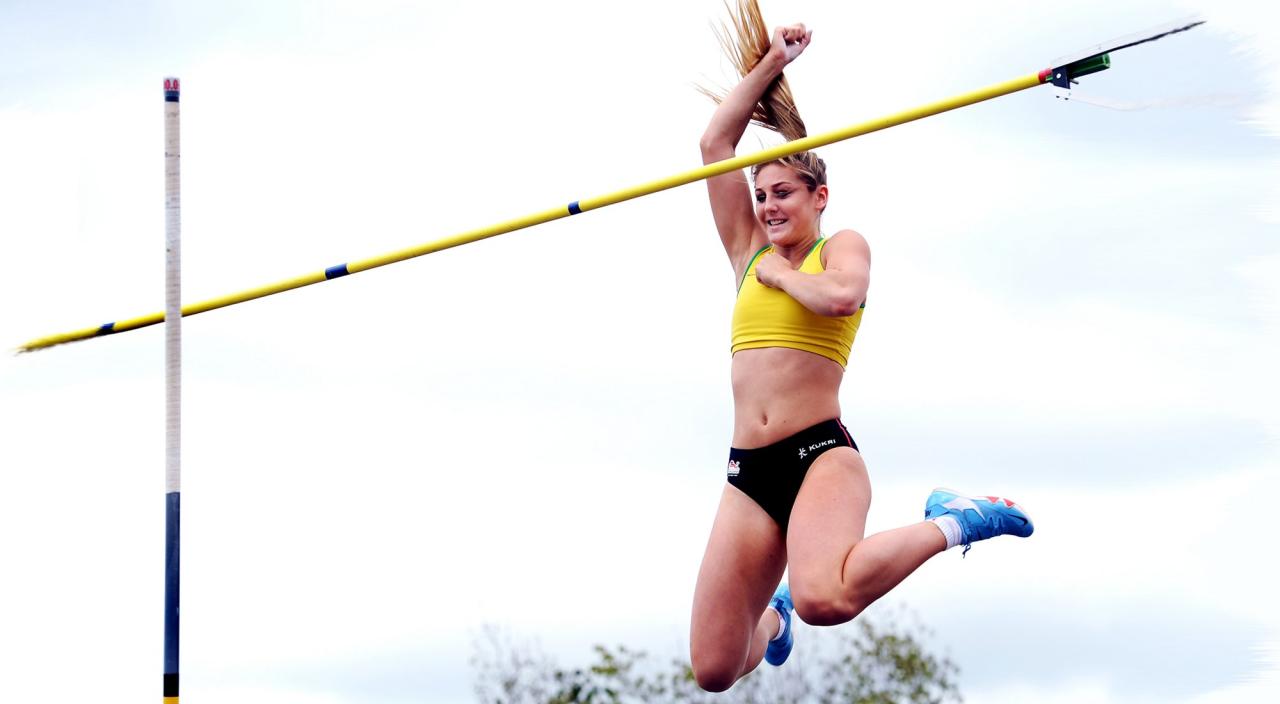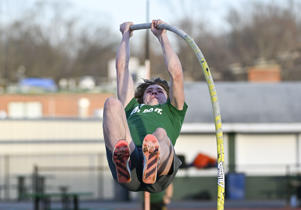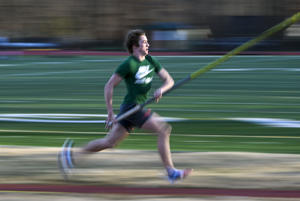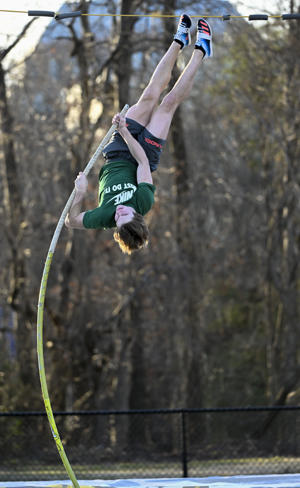
 Falls Church's Nicholas DeWolf is competing in the pole vault championship at the Virginia state meet this weekend. (Jonathan Newton/Washington Post)
Falls Church's Nicholas DeWolf is competing in the pole vault championship at the Virginia state meet this weekend. (Jonathan Newton/Washington Post)
Athletes are drawn to the pole vault for many reasons. Some seek an adrenaline rush outside of their prime gaming season. Others are tired long-range competitors.
The common denominator of all the flyers describes their main interest: it looks great.
Nicholas DeWolf of Junior Falls Church recalls how Olympic gold medalist Armand Duplantis rose 20 feet into the air before sliding onto the foam padding below, and "wanted to see what it looked like," DeWolf says.
Junior Osborne Park responded to the same Viviana Rodríguez. Even as a former gymnast, she couldn't have imagined achieving such technical perfection, until she tried. "It always looked cool: people were running around with big sticks and then they just blew up," Rodriguez said.
Pole vaulting is, at its core, a highly technical sport that requires a balance of speed, strength, agility, and body awareness. While most sports rely on basic movements like running or throwing a ball, pole vaulting requires athletes to retrain their minds and muscles to accommodate the movements they don't have. I may never try.
It also combines skills that are often mutually exclusive. Having core and shoulder strength isn't enough to leap through the air and leap forward; You also need to be able to run like a sprinter. The drop experience is awesome, but can you do it while carrying a 14ft pole?
DeWolfe and Rodriguez are among the best newer outfield players to emerge from Northern Virginia. Many coaches say that the most important keys to success in sports are: speed (because strength and technique can be developed over time) and determination (because jumping requires a huge mental load).
They are aiming for a title at the Virginia Indoor Championships this weekend.
 The speed helped DeWolfe stand out. (Jonathan Newton/Washington Post)
The speed helped DeWolfe stand out. (Jonathan Newton/Washington Post)
learn the basics
Beginners start with a series of exercises before moving up to the barre. They must first learn to grip the bar near the top with their dominant hand. You will then undergo basic speed and strength training designed to build enough momentum to get you started.
Once they're ready to approach the hole, it's time to measure the length and speed of each step so they don't hesitate to jump.
A popular drill known as "One-Two-Three, Plant-Two-Three" breaks the last six stages of the vault into a carefully choreographed routine of placing the studs in the box and timing them to get started.
DeWolfe, who started pole vaulting a little over a year ago, came to the track as a multi-athlete looking for ways to stay in shape during home football season.
"When I started, it was a completely foreign concept," he says. “So you just need to get used to standing on the pole on day one. You are not even allowed to enter the hole. Just build confidence with the bar and start to understand how the movements work.
 DeWolfe aimed at 15 feet. (Jonathan Newton/Washington Post)
DeWolfe aimed at 15 feet. (Jonathan Newton/Washington Post)
Coming from lacrosse and football, where he was a catcher and outfielder, DeWolf did not have the typical build of a pole vaulter. At 6-foot-170 pounds, he was stronger and heavier than most outfielders. He learned to use this to his advantage to move faster on longer clubs with higher weight limits, often creating more feathers on the club and reaching new heights.
DeWolfe is considered a work in progress, but he placed second in last year's indoor VHSL competition, jumping 13 feet in just a few months.
"The hardest part is that you're really focused on your job, but once you start competing, your head just goes blank," says DeWolf. "It has to go directly to muscle memory."
Over the summer, DeWolf attended pole vault training camp with the Prince William County Pole Vaulters, a club made up of a network of high school coaches in Northern Virginia. He has now jumped 14½ feet and is shooting for his US personal best of 15 feet.
 Osborne Park junior Viviana Rodriguez quickly became one of the top pole vaulters in Northern Virginia. (Jerry McEvoy)
Osborne Park junior Viviana Rodriguez quickly became one of the top pole vaulters in Northern Virginia. (Jerry McEvoy)
get the trick
For at least the last decade, the Northern Virginia team has become the dominant force in pole vaulting, thanks in large part to the pole vault program developed in Prince William County. In a sport based on complex processes, coaches' experience goes a long way in developing new talent, and athletes from Prince William County to Spotsylvania have attended summer programs to learn the game or take it to the next level.
"We train kids from all over the world," says program director Jerry McEvoy. “In fact, sometimes we're at a track meet and a kid comes up to us and says, 'I don't have a coach, can you help me?' ?' And we never deny a child.
McEvoy was an instructor at Osborne Park, where Rodríguez was one of his best students. McEvoy likens his job to building a Lego set: finding the right pieces for your crafting technique and removing the unnecessary ones to take them to the next level.
Rodriguez's success almost always comes from being 'on the same page' with his coach, but both agree that he sees great value in hearing multiple opinions about his technique.
"Sometimes when [McEvoy] is explaining something to me, I'm like, 'I know what you want me to do, but I just didn't approach it in a way that suited me,'" Rodriguez says. "Then another coach came in and interpreted it differently and all of a sudden his technique improved."
Pole vaulting is a matter of mentality for Rodríguez. It is a sport that can create great peaks by consistently reaching standards or setting deep highs or lows.
A cheerleader and former gymnast, Rodriguez began pole vaulting in the spring of her freshman year and immediately took off. But after several months of training, his progress stalled, forcing him to change his strategy and recalibrate his mindset.
"There were times when I cried during the competition," she said. "Your body isn't used to pole vaulting… You're not used to it. But to recover quickly, you have to get over it."
 Rodriguez celebrates after setting his personal best of 12 feet. (Jerry McEvoy)
Rodriguez celebrates after setting his personal best of 12 feet. (Jerry McEvoy)
Rodriguez was diagnosed with autism early in his junior year and says understanding how his brain works has helped him develop a healthy approach to exercise.
He excelled at it, winning the indoor state title last season and finishing second in the outdoor championship last spring. He still breaks down each jump into a series of techniques (running, planting, turning, landing) to improve without aiming for a certain height. His personal best is 12 feet.
"Everything was organized and there was a step-by-step approach to do everything," Rodríguez said. "There are a lot of unpredictable sports, but in pole vaulting, because it's so technical and predictable, you can easily encapsulate the specific variables of the jump."
It also helps to have a coach who knows how to handle the ups and downs of the sport. McEvoy, who was named high school and club coach of the year at last month's National Bar Vault Summit, knows how to motivate and challenge athletes. After a series of difficult jumps, he has been known to ask "One more?" – then repeat the question at least five more times until the athlete can complete the routine with a good jump.
“I always tell the kids at the blackboard, 'Trust me; It's a good idea to stick to that plan," McEvoy said. "If somebody's having a bad day, then a really good day, then a really, really bad day, they're like, 'I hate this game, but I love it. game.'
"And all the coaches looked at each other and said, 'Now that's pole vaulting.'"
